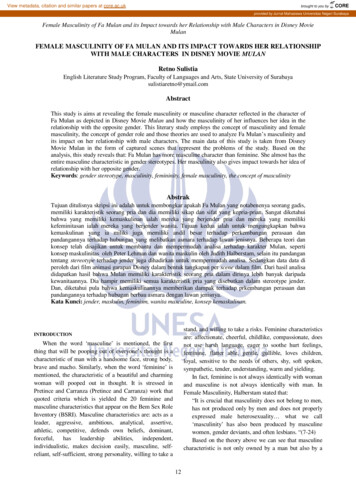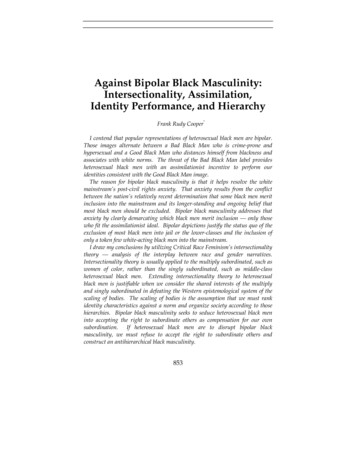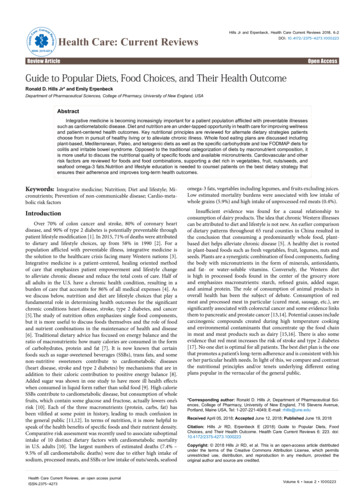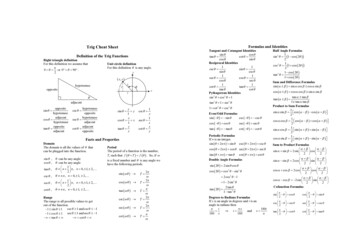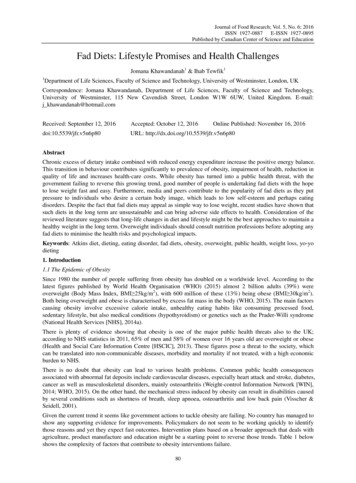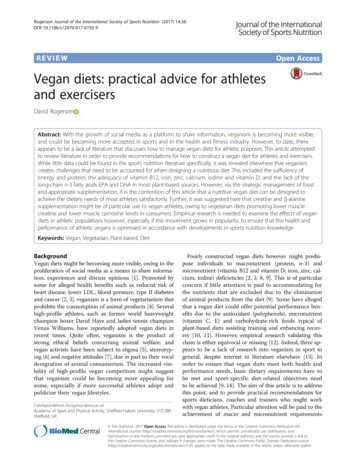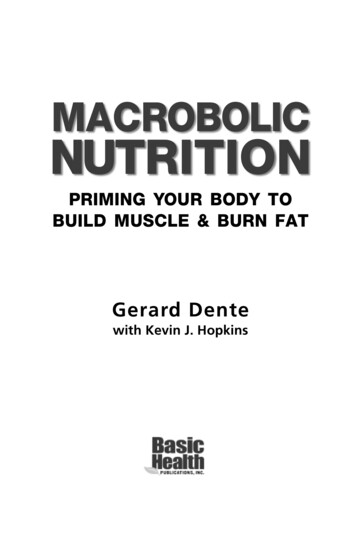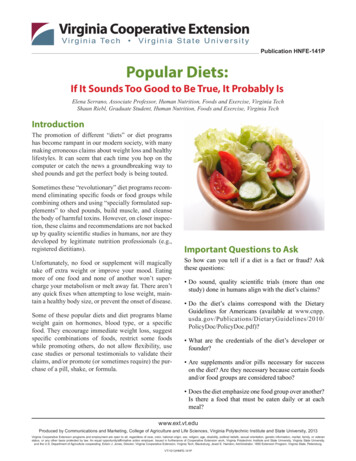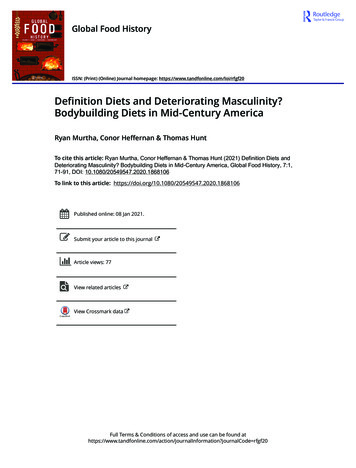
Transcription
Global Food HistoryISSN: (Print) (Online) Journal homepage: https://www.tandfonline.com/loi/rfgf20Definition Diets and Deteriorating Masculinity?Bodybuilding Diets in Mid-Century AmericaRyan Murtha, Conor Heffernan & Thomas HuntTo cite this article: Ryan Murtha, Conor Heffernan & Thomas Hunt (2021) Definition Diets andDeteriorating Masculinity? Bodybuilding Diets in Mid-Century America, Global Food History, 7:1,71-91, DOI: 10.1080/20549547.2020.1868106To link to this article: shed online: 08 Jan 2021.Submit your article to this journalArticle views: 77View related articlesView Crossmark dataFull Terms & Conditions of access and use can be found ation?journalCode rfgf20
GLOBAL FOOD HISTORY2021, VOL. 7, NO. 1, 06Definition Diets and Deteriorating Masculinity? BodybuildingDiets in Mid-Century AmericaRyan Murthaa, Conor Heffernanaaand Thomas HuntbDepartment of Kinesiology and Health Education, University of Texas, Austin, United States of America;Physical Culture and Sports, University of Texas, Austin, United States of AmericabABSTRACTARTICLE HISTORYIn the late 1960s Steve Davis, a young strength athlete turnedbodybuilder, prepared for an upcoming photoshoot by consumingnothing but meat and water. Far from unique, Davis represented anew line of bodybuilders who engaged in extreme dietary beha viors to achieve a lean and muscular look. Three decades prior toDavis’ photoshoot, Dave Willoughby, an influential weightlifter andfitness writer, promoted a diet defined by its wholesome foodseaten in moderation. Comparing the contrasts between Davis andWilloughby’s approaches, the following article sheds light on thestill relatively unexplored area of bodybuilding diets in twentiethcentury America. Studying the shift in bodybuilding from health topurely aesthetic concerns, this article argues that food for the 1970sbodybuilder became a means self-fashioning. This change wasdriven by a conflux of competitive, chemical and societal factors.The article thus addresses the nexus between food, sport andgender in the United StatesReceived 12 November 2019Accepted 21 December 2020KEYWORDSDiet; American history;bodybuilding; gender; sporthistory“What, if anything, can one do to make these addlebrained ‘Mr.’ aspirants see that theyare overdoing it?”1 So asked Dave Willoughby, in a letter from the 1970s, bemoaning thechanging esthetics that had come to dominate the sport of bodybuilding. Throughout thepreceding decades, body fat percentages plummeted among elite male bodybuilders,creating a new kind of body defined by large amounts of muscle with little body fat.Prior to the early 1960s, bodybuilders resembled the bodies exemplified by ancient Greekstatuary. By the end of the 1960s matters had changed almost irrevocably. Willoughbyclaimed that “they [bodybuilders] are not content with that, but must get rid of everyounce of subcutaneous fat until their veins are standing out as though they would burst.”2Changes in diets and training practices had produced an entirely new esthetic, onedistasteful to older coaches like Willoughby. Controlling food intake has long been ofimportance in the fitness industry. Studying the shift in bodybuilding from health topurely esthetic concerns, this article argues that food for the 1970s bodybuilder became ameans self-fashioning. Bodybuilders who ascribed to this new bodily ideal positionedthemselves as determined, masculine, and strong.3 This change was driven by a confluxof competitive, chemical, and societal factors. Adherence to the esthetic ideal reviled byCONTACT Conor Heffernanconor.heffernan@austin.utexas.eduThis article has been corrected with minor changes. These changes do not impact the academic content of the article. 2021 Informa UK Limited, trading as Taylor & Francis Group
72R. MURTHA ET AL.Willoughby required both control over food and its denial. If bodybuilding often acts as aforum for hyper-realized masculinities, food played a pivotal role in this process.Tanfer Emin Tunc’s study of The Drinking Man’s Diet (1964), highlights the diet’srelationship to a perceived “softening of American masculinity.”4 Framed in this way,Tunc explains that “the diet called for a rebirth of American patriarchal masculinity andmale-bonding in the midst of social crisis.”5 For Tunc, the diet was not a neutral form ofconsumption but rather a form of self-fashioning for American men. The diet’s foodsbecame linked to elevated sites of masculinity as evidenced by the body. Tunc’s worksubstantiates that of Jeffery Sobal, who claims that “by attributing gender to particularfoods, eating masculine or feminine foods becomes semiotic.”6 Acts of preparing andconsuming food became loaded with meaning. Building on such research, this articleextends the study of food and gender as embodied by American men with an examina tion of bodybuilding diets in 1930s and 1960s America.7In other contexts, food historians have explored the very real relationship betweenfood and masculinity. Jessamyn Neuhaus’s Manly Meals and Mom’s Home Cooking:Cookbooks and Gender in Modern America, for example, ties in Cold War concernsabout a “softening” of American masculinity with how men prepared and consumedtheir food.8 Carol Adams’s seminal research has traced the long association of meat andmasculinity. Across time and space, meat has been associated with a male hunterarchetype.9 Likewise Katharina Vester traces the tensions between masculinity andfemininity of food and cooking in the United States. Cooking, dieting, and even vegetableeating have oftentimes been seen as “feminine” behaviors.10 The bodybuilding dietsdocumented here attempted to subvert these ideals, appropriating them as masculineand admirable in the pursuit of muscular bodies.Beginning with a discussion of American diets as found in the early fitness industry,the article continues by highlighting David Willoughby’s bodybuilding diets of the 1930sand 1940s. This article argues that Willoughby’s promotion of wholesome foods andGreco-Roman bodies was reflective of the general fitness industry in America at that timeand interwar concerns about Americans’ overall health and vitality. Willoughby’s diets ofthe 1930s are next contrasted with a series of weight loss diets from the 1960s. Promotedby two of the most influential bodybuilding coaches of the age, Vince Gironda and RheoH. Blair, such diets were defined by their extremeness. This shift from Willoughby toGironda and Blair spoke of changes in the sport itself, which were driven by increasedcompetitiveness, the influence of anabolic steroids, and the need to change one’s body inextreme ways. The article thus contributes to a growing literature on the relationshipbetween food and embodied genders.Bodybuilding, Food and American Life: An OverviewWriting in 2012, Jeffrey Pilcher argues that “food matters, not only as a proper subject ofstudy in its own right, but also as a captivating medium for conveying critical messagesabout capitalism, the environment, and social inequality.”11 In the case of physicalculture and bodybuilding, the same is true. Despite the growing body of literature onthe history of food and physical culture, much work remains to be done on the interac tion between the two. Previous works on vegetarianism, such as Adam D. Shprintzen’sstudy of American groups in the nineteenth century, has gone some way to filling this
GLOBAL FOOD HISTORY73gap, but there remains a lack of information on the kinds of foods and diets used toachieve unbounding health or forge a time-specific individual or group identity.12 Faddiets can, as exhibited by Peter Sterns, offer an insight into the broader cultural andpolitical climate of the age.13 The bodies such diets produce amplify these messages. InGreat Britain, for example, vegetarianism was linked to growing British radicalism andgender crises.14 One’s diet helped embody societal beliefs and masculinity, in the case ofathletes like the 1908 Olympic gold medalist Eustace Miles.As a pursuit, bodybuilding is inherently connected to food. Writing in the mid-1970s,Vince Gironda, a highly regarded coach among elite bodybuilders, claimed that body building was primarily about one’s diet rather than time spent in the gymnasium.15 Thespecified body types idealized by bodybuilders and physical culturists are reflective ofstrict forms of diet and culinary observation. It is for this reason that Susan Bordo writesthat the bodybuilder’s relationship with food borders on the obsessive.16 More specifi cally, Bordo highlights the recurring discourses of “will, purity, and perfection” found infitness discourses surrounding food and especially those imbued in bodybuilding diets.17This is not a new or isolated affair. Alan Klein’s ethnographic study Little Big Mendiscusses the dual nature of eating for those concerned with their bodies across severaldecades in bodybuilding.18 For dedicated exercisers, food was both a means of celebra tion and a source of anxiety. A surplus was needed to build the muscular body, but anexcess of body fat was abhorred and necessitated urgent action. Such thinking representsan extreme form of the fat aversion echoed in George Vigarello’s cultural interrogation ofbody fat.19 Food, for the bodybuilder, was, and is, simultaneously a means of selffashioning and a means of denial or punishment.Certainly, the early fitness promoters of the late nineteenth century found primarily inGreat Britain and North America were aware of food’s importance to their health. GeorgeHackenschmidt, a famous wrestler and weightlifter, wrote extensively on the need to eatnuts, fruits, and vegetables in their raw and uncooked state.20 So too did Eustace Miles, atennis player, physical culturist, and vegetarian athlete who eschewed meat in favor ofnuts and “proteid” supplements.21 Where Great Britain represented the hub of body building in the early twentieth century, a series of political and economic changes, notleast the Great War (1914–1918), ensured that the United States became a hub for fitnessentrepreneurs from the 1920s onwards.22 It is for this reason that far more physicalculture texts exist in the American context from the 1920s. Heather Addison has linkedAmerica’s growing concern with physical culture in the 1920s to the overall strength ofAmerican culture and industry during this period.23 Importantly, Addison cites therelationship between 1920s American physical culture and growing American concernssurrounding its geopolitical importance and a perceived gender crisis for men.It was also during this time that extreme weight loss diets first gained nationwideattention among female physical culturists pursuing a desired svelte look, commonlyreferred to as the “reducing craze.”24 Not as coherent as later diets, the “reducing” crazewas defined by the large array of approaches taken to lose weight. For some women,reducing meant calorie counting or starving. For others, it necessitated additionalproducts, supplements, or single food eating plans.25 Where Hollywood and pulpphysical culture magazines were the initial means through which individuals measuredtheir bodies and obtained information, the 1930s saw an intensification in mail orderexercise courses, especially among male physical culturists. Such mail order courses gave
74R. MURTHA ET AL.individuals a weekly or monthly opportunity to review and reflect upon their dietarypractices.Offered almost exclusively by and produced for men, mail order courses gave simpleand systematic advice on diet and exercise to be followed on a week by week basis.Entrepreneurs like Charles Atlas, who ran one of the most influential mail order courses,regularly told his “students” of the wonders of milk in curing diseases and obtainingmuscle.26 Atlas’s nutritional dictates, which were in time reiterated by Willoughby,focused on foods said to be in their “natural state.” Thus, Atlas’s mail order coursescriticized man-made foods like apple pie, which Atlas claimed was a common lunchwhen coupled with coffee for the working man. Instead he advised the consumption ofgreen, leafy salads, vegetables, lean meats, and, of course, milk.27 Atlas upheld cannedfoods, alcohol, and cigarettes as symbols of modernity’s ills. Such foods were prepack aged, designed to be eaten or consumed in a hurry, and provided little nutritionalsubstance.28 Clearly inspired by Horace Fletcher’s chew therapy from the late nineteenthcentury, whereby diners would over chew their foods, Atlas stressed slow and nutritiouseating. Such was his adherence to this model that Atlas encouraged “chewing” one’s milkto extract the full benefits.29 This was done at a time when bodybuilding and fitnesscultures were not yet competitive. Although Atlas won two separate male beauty contestsin the early 1920s, the practice of bodybuilding had not yet been born.30 This meant thatdiscourses from entrepreneurs and coaches focused more on one’s vitality than estheticappearance.Atlas’s mail order workout courses, and those of his fellow physical culture entrepre neurs like Tony Sansone, Earle Liederman, Lionel Strongfort, and Bernarr MacFadden,exhibited an intense focus on food and the kinds of bodies produced using dietarysystems. For Bernarr MacFadden, whose physical culture business ventures began inthe late nineteenth century, food held an almost mythical place for physical culturists.Accordingly, MacFadden regularly claimed through his Physical Culture magazines thathis diets could cure illnesses, improve one’s eyesight, and arrest hair loss.31 An illnourished body was seen to embody the “ills” of modernity as understood by speed,poorly manufactured products, and appealing advertising. The healthy, and muscularbody, built with nutritious foods, embodied a newer ideal which rejected the allure ofmodernity in favor of “natural” approaches. In extreme cases, an absence of food, in theform of fasting, was advocated by MacFadden for his clients. Atlas, whose introduction tothe entrepreneurial side of physical culture came from MacFadden, largely echoed thesesentiments with the proviso that few could match MacFadden’s acerbic writings onunsavory diets. MacFadden and Atlas both linked poor dietary habits to Americansociety more generally. For MacFadden, the power of orthodox medicine, the pharma ceutical industry, and industrialized foods were responsible for innumerable societal andhealth problems.32 Food, in this framework, represented a defense against these scourgesof modernity. MacFadden’s and Atlas’s calls for dietary constraint and the importance of“pure” foods were reminiscent of broader cultural anxieties regarding America’smodernization.Atlas and MacFadden, influential though they were, were not the only early physicalculturists to discuss the importance of food. Other physical culturists in the 1930s and1940s, like Tony Sansone and Lionel Strongfort, focused on food as the necessarybuilding blocks for a muscular body.33 Sansone, in particular, proved a strong advocate
GLOBAL FOOD HISTORY75of natural foods as evidenced by his muscle building diets built using milk, eggs andorgan meats.34 This emphasis on a natural diet largely distinguished them from Atlas orMacFadden who, although acknowledging the importance of food in building strength ormuscle, focused more on the importance of food for overall health and vitality. Even at anearly juncture, physical culture and bodybuilding was becoming divided along dietarylines. Ultimately, individuals began to focus far more on food as necessary for strengthrather than food as medicine. By the time Willougby began writing on diets in the late1930s, Americans had come to expect, and follow, dietary advice from influential fitnesscoaches.David Willougby and “Soft Bodies”In 1939, America’s first official bodybuilding competition was held, the Mr. Americacontest. The creation of regular bodybuilding competitions changed the manner in whichfood and the body were perceived.35 Whereas previous informal competitions hadexisted prior to this point, the creation of Mr. America competitions, with annual eventsand standardized rules, meant that the male body began to be viewed in different ways.Annual contests meant that strict criteria emerged for the male physique, albeit with theproviso that the focus remained on overall health. Whereas Atlas and MacFadden studiedthe body with terms like vitality or health, those interested in the Mr. America contestcared more for muscularity, symmetry and definition.36 Seen to represent an Americanconfidence in perfectible forms of masculinity, the show’s contestants became increas ingly regimented in their training and dietary practices. Soon diets became geared towardcompetition and building a muscular physique. This shift was found in the diets andcourses promoted by David Willoughby, one of America’s most popular physical cultur ists of the 1930s and 1940s. Willoughby’s diets were geared entirely toward this newgeneration of bodybuilders who wanted to compete in Mr. America contests or, at thevery least, emulate its competitors. In targeting these exercisers, Willoughby not onlyspoke of new bodybuilding ideals but also the society in which they were situated.Significantly, the format of the Mr. America contest was not based solely on one’sphysical appearance. Contestants were, for several decades, judged on their strength,physical appearance, and even their personality. Such criteria ensured that judges lookedfor a “holistic” winner – one who exhibited muscularity but also athletic strength. Thewinner, it must be stressed, was often the best developed white male. Prior work onphysical culture has explained the overt racism found in the late nineteenth- and earlytwentieth-century fitness industry.37 Ideal muscular bodies were presented, by default, aswhite. This pattern continued with the Mr. America contest which, although welcomingAfrican-American bodybuilders from the late 1940s, did not have an African-Americanwinner until the late 1960s, despite calls by competitors from the late 1950s onward thatthe competition was racially discriminating against deserving competitors.38David Willoughby’s understanding of the relationship between food and the body isuseful as a foil for what would come later. A contemporary of Bernarr MacFadden,Willoughby wrote at a time when bodybuilding, as a pursuit, was largely concerned withindividual health and wellbeing. A drive for muscularity existed, but there were fewcompetitions. His prescriptions were different then, from those in the 1960s and 1970s,which promoted far stricter diets in pursuit of competitive victory. Born in New Orleans
76R. MURTHA ET AL.in 1901, Willoughby spent most of his life in Southern California. He began liftingweights as a teenager, beginning in 1918 as part of his rehabilitation from an illness. In1921, he found a mentor in Al Treloar of the Los Angeles Athletic Club. ThoughWilloughby came of age too early to compete in bodybuilding competitions like theMr. America contest, he won a number of Amateur Athletic Union weightlifting cham pionships in the 1920s and was reputed for his strength as much as his figure. By the timeof his death, he was labeled “perhaps the world’s greatest weightlifting historian of ourtime.39 Champion bodybuilder and weightlifting John Grimek similarly praisedWilloughby’s writings on muscle building as “a masterpiece.”40 Willoughby also helpedform some of the earliest weight lifting organizations, he and was instrumental in thepush to standardize strength sports.41 His own fitness system may not have been aspopular with the general public as those published by competitors Charles Atlas or EarleLiederman, but Willoughby – operating in the same social milieu – had cachet amongdedicated exercisers in America.When Willoughby wrote in the 1920s and 1930s, weight lifting and bodybuildingorganizations and competitions only existed in their most protozoic forms. With noinstitutional guidance, standards for what the ideal body looked like, specifically within agiven subculture, were based largely on the opinions of influential individuals likeWilloughby. As Allan Mazur argues, standardization of beauty only came with the riseof mass media.42 Admitting some American male figures superseded the bodies ofantiquity, Willoughby still celebrated those ancient Greek athletes preserved in marble,labeling them “anthropomorphic perfection.”43 During an era in which technology wasfor the first time becoming an unavoidable intrusion on everyday life, Willoughby lookedto classical physiques from Ancient Greece, which he saw as timeless.44 This was acommon opinion among weight trainers in the United States. Earlier physique competi tions hosted by Eugen Sandow, Bernarr MacFadden, and National Police Gazette pub lisher Richard K. Fox in the early 1900s all privileged Greco-Roman understandings ofhealth. For those in the 1930s, such competitions marked the ideal forms of judging themale body. Stemming from this, it was ancient sculptures like Discobolus (a Greek discusthrower) or Laocoön (a Trojan priest fighting snakes) that Willoughby believed offeredthe best combination of looks and function, and so he both pursued such an appearancefor himself, and encouraged others to do the same.Willoughby’s success at the time likely came from the fact that the lifestyle heproposed counteracted what historian Susan Currell calls “the widespread belief thatthe country was not just economically depressed but also ‘diseased’ in some way” in theearly 1930s.45 Currell writes that “hopes for the future strength of the nation were oftenlinked to hopes for stronger and more robust mental and physical responses to thechallenges of the era.”46 Critical in this was the Economic Depression of 1929, whichshook traditional conceptions of white American masculinity across the next decade.Joseph Armengol found a return to sport and physical exercise after 1929 among menseeking to build their physiques and hence embody their masculinity.47 Willoughby’spromotion and promise of Greco-Roman bodies blended nicely with these anxieties. At atime when eugenic ideals of male and female bodies permeated parts of American society,the notion of the perfectible body grew in importance. For these reasons Willoughby’schampioning of the classically muscular body met with a ready audience of aspiringbodybuilders in America.
GLOBAL FOOD HISTORY77Additionally, Willoughby found success by offering his readers a degree of controlover their lives at a time when it seemed everything was out of control.48 Downturns inthe economy meant that five thousand banks closed in the early 1930s, while billions ofdollars were lost in savings. Attempting to preserve some liquidity in the face offrequent runs on the remaining banks, bankers called in housing loans, sparking awave of home foreclosures across the country. Business investment evaporated, andunemployment skyrocketed. Veterans of World War I marched on Washington todemand early redemption of deferred service payments, only to be forcefully drivenaway by members of the very Army in which they had served. In rural America theDust Bowl compounded problems. Social services were cut in many states while publiccommentators scoffed at the softening of American men and the greed of Wall Streetinvestors.Willoughby offered a lifeline, a way to exercise control over one’s own body, and, inturn, one’s future. His celebration of fuller bodies doubled as a call for a return toprosperity, especially at a time when the average American body was perceived to besmaller and weaker than it had been the previous generation.49 Willoughby declared thatthe “optimal or ideal man has an amount of fat equal to 11.25% of his body weight,” andabout twice that for women.50 He based this assumption from the measurements of theaforementioned Greek statuary, which he calculated had a similar body fat percentage.Such a physique was embodied for Willoughby in the first winner of the Mr. Americacompetition in 1939, Roland Essmaker, pictured below.Willoughby’s calculations suggested to him that “a similar, if not identical, standardfor the ideal masculine physique has prevailed for some 2000 years.”51 Willoughby’spreference for some level of fat was not just based on esthetic preferences; he advocatedfor its health benefits as well. Moderate amounts of fat would insulate the body from boththe cold and from blunt impacts; it would store energy; and in women, it would promotemenstruation. Willoughby’s thoughts on fat evidenced his larger belief, namely thatappearance could not overshadow function. This ideal fit well with the Mr. America’spraise for “holistic” bodies. Willoughby wrote that a well-developed, fuller physique hadmany benefits, from a firmer body to “good digestion, a cleared brain, sound sleep, andbuoyant spirits.”52 He even suggested it may have economic benefits, “when often a manis sized up and given employment, or advanced from his present, just on the strength ofhis appearance.”53 Like many of his colleagues discussed above, Willoughby had his ownmail-order fitness system, and he used it to spread his message of functional fitness. Hepromised his acolytes “big muscles a fine, athletic figure,” a fuller one than futuregenerations of bodybuilders would prefer.54Critically one could not achieve this Greek ideal through lifting alone. Rather, “health,strength and bodily shapeliness are the result, not of any one thing, but of aCOMBINATION or circle of beneficial influences.”55 Chief among these factors wasnutrition. Bodybuilding, Willoughby believed, “is 50% nutrition and 50% exercise andthe two of them must go hand in hand if worthwhile results in health and bodilydevelopment are to be obtained and retained.”56 Willoughby suggested his colleaguesdid not appreciate the importance of the relationship between physical fitness and propernutrition, writing that “specialists in exercise are inclined to disregard the influences offood on health and longevity. On the other hand, experts in nutrition are equally liable tooverlook the necessity of exercise as an invigorator of the organic functions.”57
78R. MURTHA ET AL.While physical culturists before Willoughby similarly claimed that “no amount ofexercise, however excellent, will enable one to improve physically if the diet is lacking inthe substances essential to health,” Willoughby spoke to a United States still attemptingto recover from the Great Depression.58 Where Elizabeth Applegate and Louis Grivettifound that people across millennia have altered their diets to achieve a desired outcome,the supposed scientific promises of diets grew in the twentieth century. Applegate andGrivetti explain that it was not until this time that individuals began to understand thescientific underpinnings of their eating. “Most evidence for relationships between dietand supplements and improved performance . . . stems from the early twentieth-century,with the advent of research on understanding muscle work, fuel use during exercise, andthe specific roles of protein, fat and carbohydrate.”59 Thus, when Willoughby was writingin the 1930s and 1940s, research into the composition and roles of food was onlybeginning. Yet he provided his readers with sophisticated dietary guidelines to meetwhatever their needs were. For those attempting to lose weight, Willoughby prescribed ahigh-fat, low-carbohydrate diet, limiting them to no more than 40 grams of the latterdaily.For those looking to gain weight and add muscle, Willoughby said they should eat upto six meals a day, evenly spaced. Additionally, he commanded, “Eat slowly. Chew yourfood thoroughly. Do not eat when hot, tired or excited. Do not hurry or be overactivesoon after eating . . . Never allow yourself to go hungry; always maintain that full,satisfied feeling.” Preserved or processed foods of all kinds were to be avoided, andwater was to be drunk at room temperature. After meals, Willoughby suggested thatreaders lie down with their feet elevated, which “allows the blood to stay around thedigesting organs.”60The diet Willoughby described for his clients placed great emphasis on the type ofprotein they were consuming. Beef and lamb chops were most desirable, he said, but porkwas harder to digest, and so should be limited, except as bacon. Duck, veal, goose,sausage, and tongues of all kinds were likewise frowned upon. Fish could be consumedonce a week, but salmon, sardines, herring, mackerel, and shellfish were to be avoided.Beans and other legumes were also rejected. Willoughby described these as “incompleteproteins,” saying they would sustain life but not support growth.61 Milk was key – raw ifone could get it, as pasteurization removed desirable vitamins. And goat’s milk, he added,was always superior to cow’s milk. Eggs were also an important part of obtainingnecessary protein, and he said to consume two or three daily, ideally poached or drankin uncooked liquid form. Vegetables should be eaten raw, and sugar substituted withhoney, molasses, or carob. Additionally, readers were warned to avoid spices and con diments of all kinds lest they agitate the digestive system by introducing too much flavor.This meant no salt or pepper, nor ketchup or mustard.One example provided by Willoughby of a good day of eating for those attempting togain muscle is as follows: breakfast at 8:00am consisting of a glass of fruit juice, a bowl ofpotatoes, either two eggs and four strips of bacon or a medium steak, two slices of toastwith butter, a glass of whole milk, and a vitamin tablet. Two hours later, one would eat asandwich on whole wheat bread, along with another glass of whole milk. At noon, lunchwould consist of a steak, hamburger, roast beef, or other plain meat, accompanied by alarge baked potato, two slices of bread and butter, a large leafy vegeta
extends the study of food and gender as embodied by American men with an examina-tion of bodybuilding diets in 1930s and 1960s America.7 In other contexts, food historians have explored the very real relationship between food and masculinit

